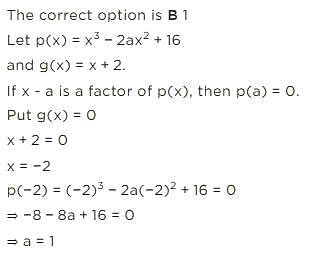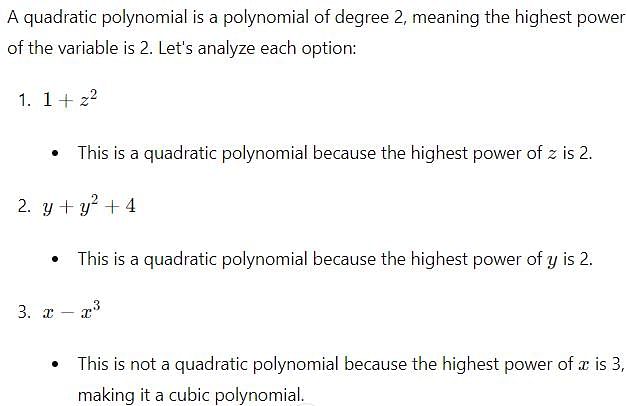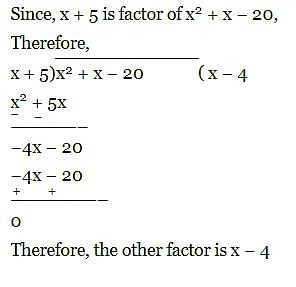Class 9 Exam > Class 9 Tests > Mathematics (Maths) Class 9 > Test: Introduction To Polynomials - Class 9 MCQ
Test: Introduction To Polynomials - Class 9 MCQ
Test Description
20 Questions MCQ Test Mathematics (Maths) Class 9 - Test: Introduction To Polynomials
Test: Introduction To Polynomials for Class 9 2025 is part of Mathematics (Maths) Class 9 preparation. The Test: Introduction To Polynomials questions and answers have been
prepared according to the Class 9 exam syllabus.The Test: Introduction To Polynomials MCQs are made for Class 9 2025 Exam. Find important
definitions, questions, notes, meanings, examples, exercises, MCQs and online tests for Test: Introduction To Polynomials below.
Solutions of Test: Introduction To Polynomials questions in English are available as part of our Mathematics (Maths) Class 9 for Class 9 & Test: Introduction To Polynomials solutions in
Hindi for Mathematics (Maths) Class 9 course. Download more important topics, notes, lectures and mock
test series for Class 9 Exam by signing up for free. Attempt Test: Introduction To Polynomials | 20 questions in 20 minutes | Mock test for Class 9 preparation | Free important questions MCQ to study Mathematics (Maths) Class 9 for Class 9 Exam | Download free PDF with solutions
Test: Introduction To Polynomials - Question 1
If x + 2 is a factor of x3 – 2ax2 + 16, then value of a is
Detailed Solution for Test: Introduction To Polynomials - Question 1
Detailed Solution for Test: Introduction To Polynomials - Question 3
Test: Introduction To Polynomials - Question 4
If 3 + 5 – 8 = 0, then the value of (3)3 + (5)3 – (8)3 is
Detailed Solution for Test: Introduction To Polynomials - Question 4
Detailed Solution for Test: Introduction To Polynomials - Question 5
Test: Introduction To Polynomials - Question 6
If x + 2 is a factor of x3 – 2ax2 + 16, then value of a is
Detailed Solution for Test: Introduction To Polynomials - Question 6
Test: Introduction To Polynomials - Question 7
Which of the following is not a quadratic polynomial?
Detailed Solution for Test: Introduction To Polynomials - Question 7
Test: Introduction To Polynomials - Question 8
P of x = ax, a is not equal to 0. find zeros of polynmial
Detailed Solution for Test: Introduction To Polynomials - Question 8
Test: Introduction To Polynomials - Question 9
Zero of the polynomial p(x) where p (x) = ax, a ≠ 0 is:
Test: Introduction To Polynomials - Question 10
If x + 2 is a factor of x3 – 2ax2 + 16, then value of a is
Detailed Solution for Test: Introduction To Polynomials - Question 11
Detailed Solution for Test: Introduction To Polynomials - Question 12
Test: Introduction To Polynomials - Question 13
If one of the factor of x2 + x – 20 is (x + 5). Find the other
Detailed Solution for Test: Introduction To Polynomials - Question 13
Test: Introduction To Polynomials - Question 14
Which of the following is a quadratic polynomial in one variable?
Test: Introduction To Polynomials - Question 15
A cubic polynomial is a polynomial of degree …………
Detailed Solution for Test: Introduction To Polynomials - Question 15
Test: Introduction To Polynomials - Question 16
Find the value of the polynomial 6 – 4x + 3x2 at x = 3
Detailed Solution for Test: Introduction To Polynomials - Question 16
Detailed Solution for Test: Introduction To Polynomials - Question 17
Detailed Solution for Test: Introduction To Polynomials - Question 18
Test: Introduction To Polynomials - Question 19
What is the coefficient of x in x3 + 3x2 - 2x - 1
Test: Introduction To Polynomials - Question 20
The degree of the polynomial x4 – 3x3 + 2x2 – 5x + 3 is:
Detailed Solution for Test: Introduction To Polynomials - Question 20
|
44 videos|412 docs|54 tests
|
Information about Test: Introduction To Polynomials Page
In this test you can find the Exam questions for Test: Introduction To Polynomials solved & explained in the simplest way possible.
Besides giving Questions and answers for Test: Introduction To Polynomials, EduRev gives you an ample number of Online tests for practice







 An equation involving a cubic polynomial is called a cubic equation. A closed-form solution known as the cubic formula exists for the solutions of an arbitrary cubic equation.
An equation involving a cubic polynomial is called a cubic equation. A closed-form solution known as the cubic formula exists for the solutions of an arbitrary cubic equation.














